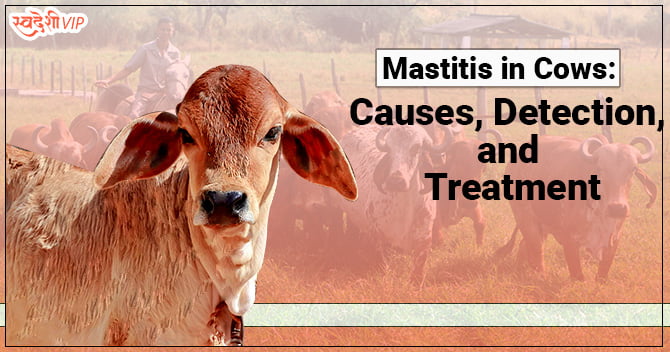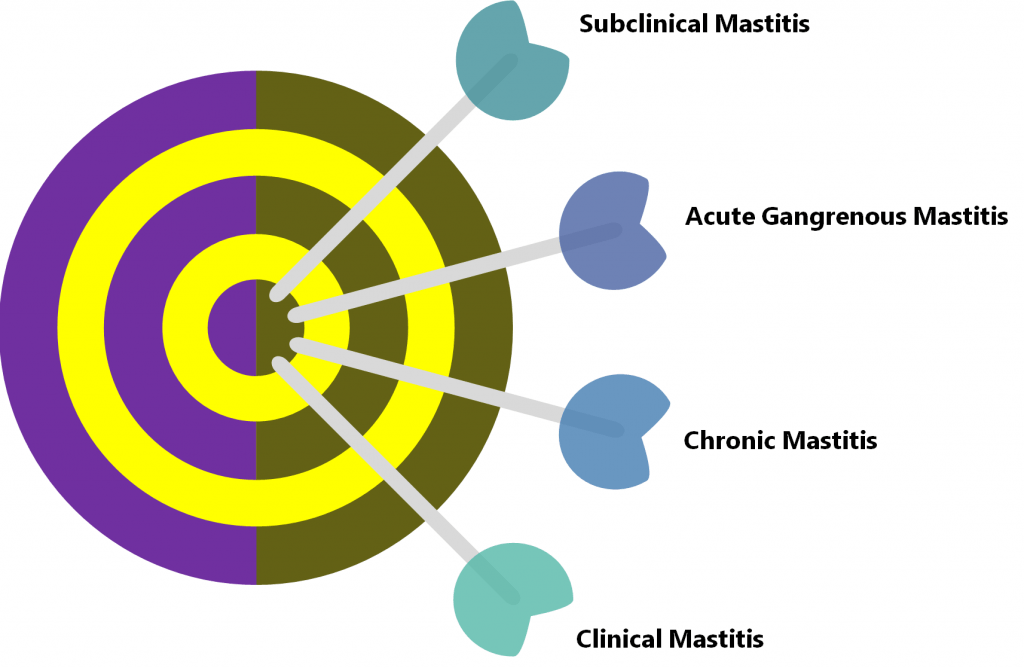
Cows can go through several diseases that can be from mild to fatal. Keeping track of everything is a vital task to keep your dairy cows in a healthy status. Mastitis in cows will not only affect your herd’s health but the quality of milk you deliver. In order to keep everything in check, you must know the basic symptoms, causes, prevention methods, and also, most importantly, how to control or treat it. So, let’s figure out all of that step-by-step.
Mastitis[1] in cows is a disease that affects the udder area of a cow. It is a sort of persistent inflammatory disease. This can be caused due to bodily abuse or bacterial infection.
Mastitis in cows is caused by bacteria penetrating the test tube. When a considerable white blood cell count (leukocytes) moves through into breast tissue, it is called mastitis. Almost every bacteria can trigger mastitis by strategically invading the teat tube. The majority of illnesses, meanwhile, are driven by streptococci (or analogous gram-positive cocci), gram-negative rods, staphylococci, and particularly lactose-fermenting intestinal microbes known as coliforms. Most infections’ principal sources of transmission can be classified as infectious or ubiquitous in epidemiological terms. However, this distinction might be confusing for some viruses.
Mastitis is characterized by infection of the mammary, which manifests as a red, firm lump. The enlarged breast gland is heated, and even contacting it gives the cow agony and suffering. To avoid milking, animals don’t accept any contact with the mammary, including pushing. Blood lumps, bad odor, brownish secretion, and milk clots are common in milk that has been milked.
The milk production comes to a halt or is greatly diminished. The cow’s temperature is high. Other signs include a poor appetite, difficulty moving due to a bloated breast, and soreness. Dead eyes, gastrointestinal issues, and nausea occur in dairy cattle.
Does Mastitis in Cows affect Milk Production?
A decrease in milk supply has been linked to mastitis in cows. It could be owing to insufficient milking of the diseased cows’ emotional irritation or obstructions or infection-related harm to milk secretory granules muscle. It’s possible that the decrease in output is momentary or irreversible.
Prevention
It’s critical to have a solid pumping regimen. Using a pre-milking udder drop or sprayer, including an iodine aerosol, and cleaning udders dry before milking is typical. After that, the pumping mechanism is used. After pumping, wipe the mammary glands once more to eliminate any microbial activity medium. Disinfect and shield among both the exposed breast as well as the microorganisms inside the air are provided by a post-milking preparation along with an iodine-propylene glycol drop. Mastitis in cows may develop after pumping since the teat pores seal within 15 minutes if the cattle is left in a filthy environment.
Unfortunately, there are variations in mastitis in cows. Here are all the types, along with how you can detect and differentiate them.

Mastitis in cows is spread most commonly by frequent interactions with milking equipment, as well as through infected hands or objects.
One way is for calves to pass the virus from mouth to udder. When calves are fed milk, a mastitis-causing bacterium type may be introduced into the calf’s mouth cavity, where it will remain latent until it has been passed further. Because clustered calves like stimulating suckling, they will transmit the infection to their companion calves’ mammary tissue. As the calf develops, the microbes will remain latent in the mammary muscle till it starts to milk. When the bacterium becomes active, it produces mastitis. To stop this method of infection, stringent calf management procedures are required.
Recognizing the symptoms is not always enough to start medications, which is why you need to confirm it medically. Here are some methods or tests you can follow to diagnose Mastitis in cows.
The best way for diagnosing most initial occurrences of clinical mastitis is to remove milk from a cow and examine it before milking. This is due to the fact that alterations in milk are frequently the first indicator of mastitis. When milk is spilled on a black surface, clumps, flakes, and color or texture changes might be noticed. Clots and flaking are more prominent in mastitis in cows caused by Staphs and Streps, whereas straw-coloured milk is usually caused by E. coli. There is a huge overlap, and other criteria must be considered before determining which medication to utilize.
One of the most efficacious approaches to detect sub-clinical mastitis is to measure somatic cell counts (SCC). White blood cells termed leukocytes make up the majority of somatic cells, which arise in reaction to the bacteria causing mastitis in cows. The amount of somatic cells per milliliter of dairy is used to calculate SCC. The higher the SCC, the more serious the infection is considered. Frequent SCC screenings will enable you to instantly recognize illnesses and take measures to preserve the health of your herds and the freshness of your dairy. SCC testing is normally done in a lab using advanced tools as part of a family farm regular herd testing routine at four-week periods or even more.
There are a few ways by which you can reduce the pain your cattle are going through. However, before using any type of drug, injection, or medication, you must ensure that you consult a medical practitioner.
Antibiotic therapy is possible; however, milk from certain cows cannot be sold until medication remnants have been removed from the cow’s body. Antibiotics could be given as an injection or pumped inward toward the teat canal along through the teat canal. Dairy staff may label afflicted cows with ribbon to caution them, and their dairy is funneled off and dumped. Specialized tests are available to evaluate if the amounts of antibiotic remnants are within the prescribed limit. Mastitis vaccines are accessible, but they must be used in combination with primary mastitis prevention because they only lessen the intensity of the ailment and do not prevent further damage.
These are aspirin-like medications that help to relieve the discomfort and irritation related to mastitis. They’ve been shown to be effective in serious forms of mastitis, and there’s now more proof that they’re also effective in ranging from mild to moderate cases. Cows given antibiotics and NSAIDs in the udder exhibited reduced cell counts, higher recovery rates, and higher ovulation than cows prescribed antibiotics only.
The Final Words
Mastitis in cows can be a gravely lethal disease that can be chaotic. In such scenarios, you must understand the pain and discomfort that your cattle are experiencing and empathize with them. Try to give them their space, and make them feel most comfortable. Follow the routines your veterinary has advised religiously, and keep your cow from milking. Once your cattle is back to normal, you can continue your milking without risking the health of the cow and the consumers. For more such informative blogs, check out our website SwadeshiVIP. We provide 100% authentic, pure, and fresh milk and its products.
Read Our Article: Calf Pneumonia: Reasons, Effects, and Treatment of the Disease
